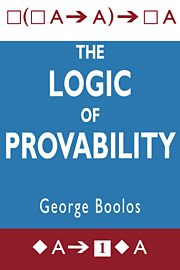Book contents
- Frontmatter
- Contents
- Preface
- Introduction
- 1 GL and other systems of propositional modal logic
- 2 Peano arithmetic
- 3 The box as Bew(x)
- 4 Semantics for GL and other modal logics
- 5 Completeness and decidability of GL and K, K4, T, B, S4, and S5
- 6 Canonical models
- 7 On GL
- 8 The fixed point theorem
- 9 The arithmetical completeness theorems for GL and GLS
- 10 Trees for GL
- 11 An incomplete system of modal logic
- 12 An S4-preserving proof-theoretical treatment of modality
- 13 Modal logic within set theory
- 14 Modal logic within analysis
- 15 The joint provability logic of consistency and ω-consistency
- 16 On GLB: The fixed point theorem, letterless sentences, and analysis
- 17 Quantified provability logic
- 18 Quantified provability logic with one one-place predicate letter
- Notes
- Bibliography
- Index
- Notation and symbols
5 - Completeness and decidability of GL and K, K4, T, B, S4, and S5
Published online by Cambridge University Press: 08 January 2010
- Frontmatter
- Contents
- Preface
- Introduction
- 1 GL and other systems of propositional modal logic
- 2 Peano arithmetic
- 3 The box as Bew(x)
- 4 Semantics for GL and other modal logics
- 5 Completeness and decidability of GL and K, K4, T, B, S4, and S5
- 6 Canonical models
- 7 On GL
- 8 The fixed point theorem
- 9 The arithmetical completeness theorems for GL and GLS
- 10 Trees for GL
- 11 An incomplete system of modal logic
- 12 An S4-preserving proof-theoretical treatment of modality
- 13 Modal logic within set theory
- 14 Modal logic within analysis
- 15 The joint provability logic of consistency and ω-consistency
- 16 On GLB: The fixed point theorem, letterless sentences, and analysis
- 17 Quantified provability logic
- 18 Quantified provability logic with one one-place predicate letter
- Notes
- Bibliography
- Index
- Notation and symbols
Summary
We are now going to establish a completeness theorem for each of the seven modal systems we have considered. We call a frame (or a model) appropriate to K4, T, B, S4, S5, or GL if and only if it is transitive, reflexive, symmetric and reflexive, transitive and reflexive, euclidean and reflexive, or transitive and converse well founded, respectively of course. All frames are appropriate to K. In Chapter 11 we shall give a general definition of a frame's being appropriate to a normal system, but as yet we have only defined the notion with respect to seven particular normal systems.
We are going to show that a modal sentence A is a theorem of one of our seven systems L if A is valid in all finite frames that are appropriate to L – equivalently, if A is valid in all finite models appropriate to L.
Thus, e.g., we shall show that if A is valid in all finite transitive and reflexive frames, then A is a theorem of S4. When we have done so, we shall have established the coextensiveness of the conditions:
validity in all transitive and reflexive frames;
validity in all finite transitive and reflexive frames;
provability in S4.
For, as we saw in Chapter 4, if A is a theorem of S4, A is valid in all transitive and reflexive frames, and thus certainly valid in all finite transitive and reflexive frames.
- Type
- Chapter
- Information
- The Logic of Provability , pp. 78 - 84Publisher: Cambridge University PressPrint publication year: 1994



